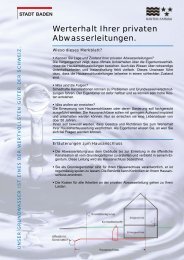Download [PDF, 5.00 MB] - Stadt Baden
Download [PDF, 5.00 MB] - Stadt Baden
Download [PDF, 5.00 MB] - Stadt Baden
Create successful ePaper yourself
Turn your PDF publications into a flip-book with our unique Google optimized e-Paper software.
9 Former Reformed Pfarrhaus (rectory)<br />
In 1725/26, the original side-gabled, late Gothic civic<br />
construction was endowed with a decorative gable by<br />
the ruling Bernese. It was the residence of <strong>Baden</strong>’s first<br />
permanent Reformed minister.<br />
10 Cordulaplatz<br />
The Mellingerturm (tower), which was destroyed in 1874,<br />
stood here, at the southern exit of the city. During the<br />
Old Zurich War, a vanguard of Zurich soldiers attempted<br />
to overcome the city of <strong>Baden</strong> on 22 October 1444, the<br />
feast day of St. Cordula. The courageous citizens of <strong>Baden</strong><br />
managed to rout out the enemy. Today, a remembrance<br />
ceremony is held every year in honour of St. Cordula.<br />
11 Haus Zum Paradies<br />
This building was constructed at the beginning of the<br />
17th century. The “Paradies” was a meeting place<br />
for important foreign diplomats, including during the<br />
European peace conference that took place in <strong>Baden</strong>,<br />
as well as elsewhere, in 1714 after the Spanish War of<br />
Succession. Exquisite Renaissance and early Baroque<br />
rooms with coffered ceilings, panelling and buffets can<br />
be found in the house’s interior.<br />
12 Bernerhaus<br />
The gabled Baroque building was erected as a show of<br />
force by the Bernese in 1676. Up until 1798, it was a<br />
place of temporary residence for Bernese court envoys.<br />
13 Kirchplatz (Church Square)<br />
The Heiliggeistspital (Holy Ghost Hospital), founded in<br />
1349 by Hungarian Queen Agnes, stood on the church’s<br />
forecourt until 1864. Queen Agnes was the daughter<br />
of Hapsburg King Albrecht, who was murdered in Königsfelden<br />
in 1308. A magnificent, late Gothic wooden<br />
cross stands in memory of the cemetery that was located<br />
beside the church. On the north side of the church,<br />
you will see a remarkable two-storied Renaissance<br />
structure with a three-dimensional model of the Mount<br />
of Olives transfiguration from 1624. The building is only<br />
open between Good Friday and Ascension Day.<br />
14 Sebastian Chapel<br />
The Sebastian Chapel, dedicated to the Saint of Plagues,<br />
St. Sebastian, was built as a chapel of the deceased<br />
over an existing burial vault at the beginning of the 16th<br />
century. It was built into part of the old city wall.<br />
15 Mariä Himmelfahrt Catholic church<br />
This church was built on the foundation of a late Carolingian<br />
and Roman site between 1457 and 1460. The<br />
chancel and the tower’s ground floor are from the 14th<br />
century. The first Baroque renovations were carried out<br />
from 1612 to 1617. The impressive painting above the<br />
high altar and the Passion pictures still remain from<br />
this period. The second Baroque renovations took place<br />
from 1696 to 1698, when the stuccowork and the<br />
images of the prophets were added to the high walls.<br />
The classicistic stuccoed ceilings, the altars, confession<br />
seats, benches and the pulpit were constructed in<br />
1813/1814 and 1829.<br />
16 Former Zeughaus (armoury)<br />
This building dates back to 1614. The monumental<br />
Renaissance portico with its relief decoration is by<br />
Bartholomäus Cades, who also created the Mount of<br />
Olives representation and the churchyard cross for the<br />
Catholic church. The intricate ironwork and the fittings<br />
for the wings of the door are the work of <strong>Baden</strong>’s<br />
master blacksmiths from the 17th century.<br />
17 <strong>Stadt</strong>haus (City Hall)<br />
The <strong>Stadt</strong>haus was built in 1497 on the site of an older<br />
city hall. The hall, where court hearings were held<br />
during the old Confederation, is on the second floor.<br />
18 Amtshaus (Council Office)<br />
During the second half of the 16th century, this building<br />
was constructed on top of the foundation of a semidetached<br />
building (market house and salt storehouse) from the<br />
14th century. The late classicistic façade portions (1878)<br />
are by <strong>Baden</strong> architect Kaspar Joseph Jeuch. The building<br />
was completely gutted from 1985 to 1987, and now a<br />
modern, new interior hides behind the original façcade.<br />
City walks 5


![Download [PDF, 5.00 MB] - Stadt Baden](https://img.yumpu.com/23223976/8/500x640/download-pdf-500-mb-stadt-baden.jpg)
![Verzeichnis der Baudenkmäler [PDF, 2.00 MB] - Stadt Baden](https://img.yumpu.com/23383916/1/184x260/verzeichnis-der-baudenkmaler-pdf-200-mb-stadt-baden.jpg?quality=85)
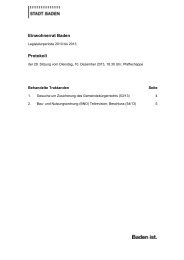
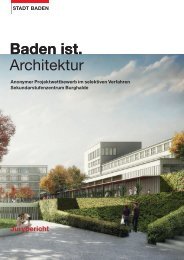
![Download [PDF, 7.80 MB] - Stadt Baden](https://img.yumpu.com/23383910/1/184x260/download-pdf-780-mb-stadt-baden.jpg?quality=85)
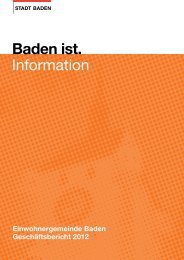
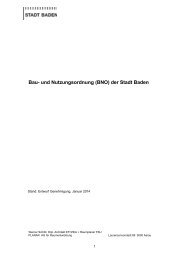
![Protokoll [PDF, 441 KB] - Stadt Baden](https://img.yumpu.com/22416795/1/184x260/protokoll-pdf-441-kb-stadt-baden.jpg?quality=85)
![Kappelerhof Planungsbericht [PDF, 410 KB] - Stadt Baden](https://img.yumpu.com/22412055/1/184x260/kappelerhof-planungsbericht-pdf-410-kb-stadt-baden.jpg?quality=85)
![Protokoll [PDF, 362 KB] - Stadt Baden](https://img.yumpu.com/22331292/1/184x260/protokoll-pdf-362-kb-stadt-baden.jpg?quality=85)
![Alte Schmiede; Baukredit [PDF, 4.00 MB] - Stadt Baden](https://img.yumpu.com/22285507/1/184x260/alte-schmiede-baukredit-pdf-400-mb-stadt-baden.jpg?quality=85)
![Flyer Schulsozialarbeit Eltern [PDF, 1.00 MB] - Stadt Baden](https://img.yumpu.com/22273610/1/190x128/flyer-schulsozialarbeit-eltern-pdf-100-mb-stadt-baden.jpg?quality=85)
![Download [PDF, 5.00 MB] - Stadt Baden](https://img.yumpu.com/21993444/1/180x260/download-pdf-500-mb-stadt-baden.jpg?quality=85)
![54-13_BNO_Teilrevision [PDF, 607 KB] - Stadt Baden](https://img.yumpu.com/21993443/1/184x260/54-13-bno-teilrevision-pdf-607-kb-stadt-baden.jpg?quality=85)
